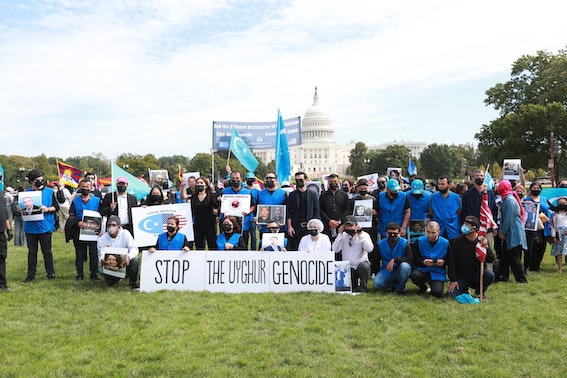As of 25 February 2021, the Dutch Parliament has declared that the People’s Republic of China is committing genocide upon its Uyghur population.[1] This accusation follows a number of alarming reports by human rights organisations and the media. China is allegedly imprisoning approximately one million Uyghurs in so called ‘re-education camps’, where they are subjected to ill treatment and torture. Women are being sterilised against their will and the detained are subjected to forced labour.[2] Preceding the Dutch Parliament, the Trump administration had labelled the Chinese treatment of Uyghurs as genocide on January 19th 2021 and current president Joe Biden agrees with the statement.[3] The Canadian Parliament has voted to acknowledge genocide on the Uyghurs at the hands of China as well, but similarly to the Netherlands, the Canadian government under Justin Trudeau is reluctant to label China’s behaviour as such.[4]
First, let’s have a look at what constitutes genocide. When declaring genocide, all abovementioned states have invoked UN Resolution 260, better known as the Genocide Convention. Article II of the Genocide Convention defines an act as genocidal when it is committed with intent to destroy, in whole or in part, a national, ethnical, racial or religious group, as such:
(a) Killing members of the group;
(b) Causing serious bodily or mental harm to members of the group;
(c) Deliberately inflicting on the group conditions of life calculated to bring about its
physical destruction in whole or in part;
(d) Imposing measures intended to prevent births within the group;
(e) Forcibly transferring children of the group to another group.[5]
However, the history of what constitutes genocide goes back further. The term genocide was first coined by international law scholar Raphael Lemkin.[6] He foresaw genocide to consist of two components: physical and cultural genocide. He described physical genocide as the killing of individual members of a certain group, while with cultural genocide, he meant the destruction of the cultural patterns of a certain group.[7] Lemkin identified cultural genocide to be the most important part of the definition.[8] To Lemkin, genocide was more than the destruction of people by direct physical extermination. However, in the definition of genocide that was ultimately adopted in the Genocide Convention, cultural genocide was not included, mainly because of the risk that the scope of genocide would be seen as too broad if it did.[9] This led to the predominant conception of genocide as racial mass murder.[10]
The events described by human rights organizations could undoubtedly uphold the accusation of physical genocide against the Uyghur population of China. However, cultural genocide often precedes or collides with physical genocide. In the unlikely event that the United Nations will declare the situation in Xinjiang as genocide and the Uyghur population is released from concentration camps, the people there will not be free from cultural oppression. Furthermore, holding China legally accountable for genocide will be a challenge, as they are not party to the Rome Statute, the constituting document of the ICC. This means it would be difficult, if not impossible, to try China for the crime of genocide before the ICC. What remains as a possibility to express dissatisfaction is imposing sanctions, which the US, Canada, the UK and the EU have done.[11] The financial damage that the sanctions will cause remains unclear, although the sanctions may deliver a symbolic punch.
Genocide is a serious allegation and it is understandable that states do not label an action as genocide lightly. Still, the reports and signals released by human rights organizations are quite serious as well, and the Uyghur population has no use for symbolic punches. Perhaps what could help them is a strong international response to human rights violations, especially by those states claiming human rights to be of paramount importance.
[1] Kamerstukken II 2020/21, 21501, 2284.
[2] BBC, ‘Who are the Uighurs and why is China being accused of genocide?’ (BBC 26 March 2021) <https://www.bbc.com/news/world-asia-china-22278037> accessed 8 May 2021; Human Rights Watch, ‘Break Their Lineage, Break Their Roots’ (Human Rights Watch 19 April 2021) <https://www.hrw.org/report/2021/04/19/break-their-lineage-break-their-roots/chinas-crimes-against-humanity-targeting> accessed 8 May 2021.
[3] Austin Ramzy, ‘China’s Oppression of Muslims in Xinjiang, Explained’ (The New York Times 5 April 2021) <https://www.nytimes.com/2021/01/20/world/asia/china-genocide-uighurs-explained.html> accessed 8 May 2021.
[4] Leyland Cecco, ‘Canada votes to recognize China’s treatment of Uighur population as genocide’ (The Guardian 22 February 2021) <https://www.theguardian.com/world/2021/feb/22/canada-china-uighur-muslims-genocide> accessed 8 may 2021.
[5] UNGA res 260 (12 January 2021) UN Doc A/RES/260.
[6] Polly Higgins, Damian Short and Nigel South, ‘Protecting the planet: A proposal for a law of ecocide’ (2013) 59 Crime, Law and Social Change 251.
[7] Raphael Lemkin, Axis rule in occupied Europe: laws of occupation – analysis of government – proposals for redress (Carnegie Endowment for International Peace 1944).
[8] A. Dirk Moses ‘Raphael Lemkin, Culture, and the Concept of Genocide’ in Donald Bloxham & A. Dirk Moses (eds) The Oxford Handbook of Genocide Studies (OUP 2010).
[9] Samuel Totten and Henry Theriault, The United Nations Genocide Convention: An Introduction. (UTP 2020).
[10] Higgins and others (n 6).
[11] Nahal Toosi, ‘U.S., allies announce sanctions on China over Uyghur ‘genocide’’ (Politico 22 March 2021) <https://www.politico.com/news/2021/03/22/us-allies-sanctions-china-uighers-genocide-477434> accessed 8 may 2021.








